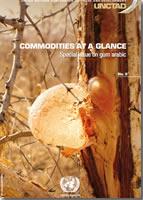
Gum arabic is a dried exudate obtained from the stems and branches of certain species from the Acacia genus. Given its many desirable properties, safety record and natural origin, it is the most commercially valuable exudate gum, with wide applications in industries as diverse as food and beverages, pharmaceuticals, cosmetics, printing, ceramics, photosensitive chemicals, pyrotechnics, textiles, paper, ink, paints and adhesives.
Produced primarily in arid wooded savannas in sub-Saharan Africa, but also in smaller quantities in South Asia and the Arabian Peninsula, gum arabic is consumed predominantly by manufacturers in developed and emerging economies.
Exports of crude and semiprocessed gum arabic almost tripled in the last 25 years, from an annual average of 35,000 tons in 1992–1994 to an annual average of 102,000 tons in 2014–2016. In addition, exports of processed gum arabic more than tripled, from 17,000 tons to 53,000 tons in the same period.
Export revenues reached an estimated average of $337 million per year in 2014–2016, 44 per cent of which accrued to crude and semi-processed gum and 56 per cent to processed gum. Overcoming the uneven distribution of economic gains along the value chain by increasing local processing and ensuring higher compensation for resource-poor gum collectors are among the main challenges faced by producing countries.
Due to its potential to generate foreign exchange reserves, ensure food security, promote sustainable agriculture and forestry, and combat desertification and climate change, gum arabic is a promising commodity for a number of sub-Saharan African countries. It has the potential of playing a critical role in producer countries’ efforts to achieve the Sustainable Development Goals set forth in the 2030 Agenda for Sustainable Development.
This issue of the Commodities at a Glance series explores the economic, social and environmental relevance of the gum arabic sector, with a focus on supply, demand, prices and market organization. Its aim is to present information in a clear, concise and reader-friendly format. In particular, the report makes an important contribution by constructing a comprehensive and improved dataset on crude and processed gum arabic trade flows.
This special issue on gum arabic is organized in six chapters.
-
Chapter II reviews the history, regulatory status, geographical distribution, ecological characteristics and biochemical properties and functions of gum arabic.
-
Chapter II discusses traditional uses and modern industrial applications.
-
Chapter III describes the gum arabic value chain, with a focus on the main agents at different stages of transformation.
-
Chapter IV examines global supply and demand for crude and processed gum arabic.
-
Chapter V analyses the evolution of gum arabic prices over time and across countries and product types.
-
Chapter VI presents policy recommendations and concludes the report.


